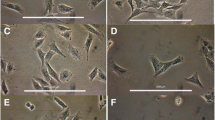Abstract
Stellate cells are principal producers of extracellular matrix proteins in the liver and play a major role in the development of liver fibrosis. Molecular basis of the cell activation has therefore been analyzed intensively during the past decade. Proteomics analysis is one of the most powerful tools with which to reveal the total protein synthesis in stellate cells, in particular the dynamic change in their expression level in response to activation. We have successfully analyzed over 300 stellate cell proteins by proteomics, several of which represented activation-associated change. Change in the level of some of these proteins was confirmed in liver tissue level. In addition, this approach led to the discovery of a novel globin in the vertebrate. Thus, proteomics is a research method for comprehensive understanding of the molecular basis of liver fibrosis.
Access this chapter
Tax calculation will be finalised at checkout
Purchases are for personal use only
Similar content being viewed by others
References
Blomhoff, R. and Wake, K. (1994) Perisinusoidal stellate cells of the liver; important roles in retinol metabolism and fibrosis. FASEB J. 5, 271–277.
Friedman, S. L. (1993) The cellular basis of hepatic fibrosis. N. Engl. J. Med. 328, 1828–1835.
Gressner, A. M. and Bachem, M. G. (1995) Molecular mechanism of liver fibrosis-a homage to the role of activated fat-storing cells. Digestion 56, 335–346.
Olaso, E. and Friedman, S. L. (1998) Molecular regulation of hepatic fibrogenesis. J. Hepatol. 29, 836–847.
Kawada, N. (1997) The hepatic perisiunusoidal stellate cell. Histol. Histopathol. 12, 1069–1080.
Kim, Y., Ratziu, V., Choi, S. G., et al. (1998) Transcriptional activation of transforming growth factor beta1 and its receptors by the Kruppel-like factor Zf9/core promoter-binding protein and Sp1. Potential mechanisms for autocrine fibrogenesis in response to injury. J. Biol. Chem. 273, 33,750–33,758.
Marra, F., Gentilini, A., Pinzani, M., et al. (1997) Phosphatidylinositol 3-kinase is required for platelet-derived growth factor’s actions on hepatic stellate cells. Gastroenterology 112, 1297–1306.
Kawada, N., Ikeda, K., Seki, S., and Kuroki, T. (1999) Expression of cyclins D1, D2 and E correlates with proliferation of rat stellate cells in culture. J. Hepatol. 30, 1057–1064.
Hellerbrand, C., Stefanovic, B., Giordano, F., Burchardt, E. R., and Brenner, D. A. (1999) The role of TGF beta1 in initiating hepatic stellate cell activation in vivo. J. Hepatol. 30, 77–87.
George, J., Roulot, D., Koteliansky, V. E., and Bissell, D. M. (1999) In vivo inhibition of rat stellate cell activation by soluble transforming growth factor beta type II receptor: a potential new therapy for hepatic fibrosis. Proc. Natl. Acad. Sci. USA 96, 12,719–12,724.
Kawada, N., Tran-Thi, T. A., Klein, H., and Decker, K. (1993) The contraction of hepatic stellate (Ito) cells stimulated with vasoactive substances. Possible involvement of endothelin 1 and nitric oxide in the regulation of the sinusoidal tonus. Eur. J. Biochem. 213, 815–823.
Rockey, D. C. and Weisiger, R. A. (1996) Endothelin induced contractility of stellate cells from normal and cirrhotic rat liver: implications for regulation of portal pressure and resistance. Hepatology 24, 233–240.
O’Farrell, P. H. (1975) High resolution two-dimentional electrophoresis of proteins. J. Biol. Chem. 250, 4007–4021.
Roepstorff, P. (1997) Mass spectrometry on protein studies from genome to function. Curr. Opin. Biotechnol. 8, 6–13.
Yates, J. R. (1998) Mass spectrometry and the age of the proteome. J. Mass. Spectrom. 33, 1–19.
Kristensen, D. B., Kawada, N., Imamura, K., et al. (2000) Proteome analysis of rat hepatic stellate cells. Hepatology 32, 268–277.
Kristensen, D. B., Imamura, K., Miyamoto, Y., and Yoshizato, K. (2000) Mass spectrometric approaches for the characterization of proteins on a hybrid quadrupole time-of-flight (Q-TOF) mass spectrometer. Electrophoresis 21, 430–439.
Maeda, N., Kawada, N., Seki, S., et al. (2003) Stimulation of proliferation of rat hepatic stellate cells by galectin-1 and galectin-3 through different intracellular signaling pathways. J. Biol. Chem. 278, 18,938–18,944.
Kawada, N., Kristensen, D. B., Asahina, K., et al. (2001) Characterization of a stellate cell activation-associated protein (STAP) with peroxidase activity found in rat hepatic stellate cells. J. Biol. Chem. 276, 25,318–25,323.
Sawai, H., Kawada, N., Yoshizato, K., Nakajima, H., Aono, S., and Shiro, Y. (2003) Characterization of the heme environmental structure of cytoglobin, a fourth globin in humans. Biochemistry 42, 5133–5142.
Natsume, T., Yamauchi, Y., Nakayama, H., et al. (2002) A direct nanoflow liquid chromatography-tandem mass spectrometry system for interaction proteomics. Anal. Chem. 74, 4725–4733.
Acknowledgments
The author thanks Prof. Katsutoshi Yoshizato (Hiroshima University, Japan), Dr. Dan Bach Kristensen (MDS Denmark, Denmark), Drs. Naoto Maeda and Yukihiro Imanishi (Osaka City University, Japan), and Miss Hiroko Matsui (Osaka City University, Japan) for their co-working, comments, and discussion.
Author information
Authors and Affiliations
Editor information
Editors and Affiliations
Rights and permissions
Copyright information
© 2005 Humana Press Inc.
About this protocol
Cite this protocol
Kawada, N. (2005). Analysis of Proteins Dominantly Expressed in Hepatic Stellate Cells of Activated Phenotype. In: Varga, J., Brenner, D.A., Phan, S.H. (eds) Fibrosis Research. Methods in Molecular Medicine, vol 117. Humana Press. https://doi.org/10.1385/1-59259-940-0:371
Download citation
DOI: https://doi.org/10.1385/1-59259-940-0:371
Publisher Name: Humana Press
Print ISBN: 978-1-58829-479-1
Online ISBN: 978-1-59259-940-0
eBook Packages: Springer Protocols




